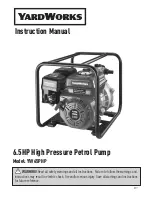
Valve can be opened by removing the plunger cap and fully
inserting a hex wrench into the stem and backing out counter-
clockwise until valve stem just touches retaining ring.
CAUTION: If visual verification ot the valve stem reaching the
retaining ring is impossible, stop backing out the
valve stem when the slightest increase in resis-
tance is felt. Because of the small size and there-
fore the reduced resistance, back out the liquid
valve 5 turns maximum to prevent going past the
retaining ring.
WARNING: If the valve stem is backed out past the retaining
ring, the O’ring can be damaged causing leakage
or system pressure could force the valve stem out
of the valve body possibly causing personal injury.
In the event the retaining ring is missing, do not
attempt to open the valve.
Replace plunger cap finger tight, then tighten an additional 1/12
turn (1/2 hex flat). Cap must be replaced to prevent leaks.
LINE INSTALLATION
Install the refrigerant lines using the following procedure:
1. Remove the cap and Schrader core from both the liquid and
vapor fitting service ports at the outdoor unit. Connect low
pressure nitrogen to the liquid line service port.
2. Braze the liquid line to the liquid fitting at the outdoor unit.
Be sure to wrap the fitting body with a wet rag. Allow the
nitrogen to continue flowing.
3. Carefully remove the rubber plugs from the evaporator
liquid and vapor connections. Use caution, since the evapo-
rator is pressurized.
4. Braze the liquid line to the evaporator liquid connection. The
nitrogen should now be flowing through the evaporator coil.
5. Remove the grommet from the vapor connection at the coil.
Braze the vapor line to the evaporator vapor connection.
After the connection has cooled, replace the grommet.
6. Protect the vapor fitting with a wet rag and braze the vapor
line connection. The nitrogen flow should be exiting the
system from the vapor service port connection. After This
connection has cooled, remove the nitrogen source from
the liquid fitting service port.
7. Evacuate the vapor line, indoor coil and the liquid line. See
"EVACUATION" at top of page 9.
NOTE: Do not use the system refrigerant in the outdoor unit
to purge or leak test.
8. Leak test all refrigerant piping connections including the
service port flare caps to be sure they are leak tight. DO
NOT OVERTIGHTEN (between 40 and 60 inch - lbs. maxi-
mum).
9. Do not remove the flare caps from the service ports except
when necessary for servicing the system.
CAUTION: Do not connect manifold gauges unless trouble is
suspected. Approximately 3/4 ounce of refrigerant
will be lost each time a standard manifold gauge is
connected.
10. Release refrigerant charge into the system. Open both the
liquid and vapor fittings by removing the plunger cap and
with an allen wrench back out counter-clockwise until valve
stem just touches retaining ring. See Base Valve Connec-
tion Precautions.
11. The sweat connect outdoor unit contains enough refriger-
ant charge for a matched evaporator and 15 feet of tubing.
Refer to the Table 3 for the amount of additional charge
required for some mix-matched evaporators. Additional
charge for lines longer than 15 feet is shown in Table 4. If
additional charge is required, see recommended charging
methods.
12. Insulate the vapor service valve and exposed line leaving
the outdoor unit. This will eliminate the outdoor sensor
picking up false heat at low ambient heating conditions.
ROOM THERMOSTAT
Heat pump units must use one of the specific thermostats
approved for use with these heat pump systems. The cooling
and heating anticipators are non-adjustable in these thermo-
stats.
The thermostat should be located about 5 ft. above the floor,
where it will be exposed to normal room air circulation. Do not
place it on an outside wall or where it is exposed to the radiant
effect from exposed glass or appliances, drafts from outside
doors or supply air grilles.
Mount the thermostat and route the 24-volt control wiring (NEC
Class 2) from the thermostat to the indoor and outdoor units.
To eliminate erratic operation, seal the hole in the wall at the
thermostat with permagum or equivalent to prevent air drafts
affecting the anticipators in the thermostat.
Route the control wiring into the outdoor unit through the hole
provided. Connect the control wiring, see Figure 3 Typical Field
Wiring.
FIGURE 7 - HEAT PROTECTION
FIGURE 8 - OUTDOOR UNIT SHUT-OFF VALVE
515.26-N1Y
8
Central Environmental Systems






























